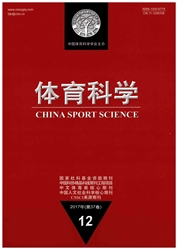

 中文摘要:
中文摘要:
目的:记录并观察大鼠在一次力竭运动过程及恢复期皮层运动区皮层脑电(Electro—corticogram,ECoG)的变化特征,揭示运动性疲劳形成的中枢机制。方法:通过神经电生理学皮层脑电记录方法,记录大鼠在一次性力竭跑台运:为过程中及恢复期皮层运动区的ECoG,动态分析运动性疲劳形成和恢复过程中ECoG频率谱、功率谱的变化特征。结果:大鼠在一次性运动疲劳的形成和恢复过程中ECoG特征会发生显著变化,运动状态下ECoG功率谱总功率显著高于安静状态(P〈0.05),在6~9Hz频段出现密集的高能量分布;大鼠疲劳状态下运动ECoG功率谱频率分配与非疲劳状态下运动具有显著性差异(P〈0.05),表现为δ波比例显著增加,而α波比例显著下降(P〈0.05)。力竭即刻频率分配与运动前安静状态差异显著,表现为δ波比例显著增加,θ波比例显著下降(P〈O.05),但在30min恢复期后,频率分配恢复至运动前的状态;在力竭运动过程中大鼠ECoG功率谱重心频率逐渐向低频迁移,在力竭前10min显著低于运动前水平(P〈0.05),当运动停止后,重心频率即向高频迁移,30min即恢复至运动前水平。结论:运动性中枢疲劳的形成是一个连续累积的过程,大鼠ECoG在运动性疲劳的形成和发展过程均伴随着占节律比例的显著增加,提示,慢波艿节律可能是运动性疲劳的重要中枢机制之一。同时,运动疲劳所导致的ECoG变化恢复非常迅速,运动停止后短时间内(30min)即能得到有效的恢复。
 英文摘要:
英文摘要:
Objective:The aim of this research is to study the central mechanism of exercise-in- duced fatigue by the observation of rats' ECoG during and after exhaustive exercise. Methods. To record the ECoG of rats during the development and recovery of exercise-induced fatigue by the Electrophysiologic method and analyze the changes of power spectrum, frequency spectrum characters of ECoG. Results: In exercise condition, the total power of ECoG power spectrum was significantly higher than that of rest condition(P-(0.05) and the main energy distribution of ECoG frequency was 6 - 9 Hz; There is significantly difference of ECoG frequency distribu- tion between exercises with and without fatigue (P 〈 3. 05). The. δ wave increased and the a wave decreased(P〈0.05) ; Also, significant difference of ECoG frequency distribution existed between before and immediately after exhaustive exercise(P〈0.05). As the δ wave increased and the θ wave decreased (P〈0. 05). However, the ECoG frequency distribution recover to that of pre-exercise in 30 minutes of recovery time; The gravity frequency of ECoG continu- ously decreased during the exhaustive exercise and significantly difference occurred when the rats exhausted (P〈0. 05) ,Whereas, it recover back to pre-exercise level in 30 minutes of re- covery time. Conclusion.. The development of exercise-induced central fatigue is a gradually ac- cumulative process. Both the development and formation of central fatigue during exercise are with the δ wave increase in ECoG. The result indicated that the increase of δ wave may be an important central mechanism of exercise-induced fatigue. However, the changes of ECoG caused by exhaustive exercise could recovery soon after exhaust.
 同期刊论文项目
同期刊论文项目
 同项目期刊论文
同项目期刊论文
 Increased extracellular dopamine and 5-hydroxytryptamine levels contribute to enhanced subthalamic n
Increased extracellular dopamine and 5-hydroxytryptamine levels contribute to enhanced subthalamic n Applying H-1 NMR Spectroscopy to Detect Changes in the Urinary Metabolite Levels of Chinese Half-Pip
Applying H-1 NMR Spectroscopy to Detect Changes in the Urinary Metabolite Levels of Chinese Half-Pip 期刊信息
期刊信息
